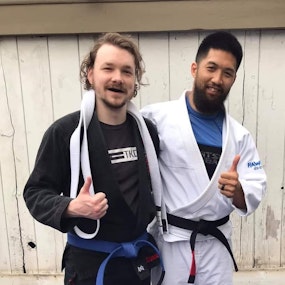Positional sparring is consistent with the Scalable Live Training (SLT) methodology but tends to have a less flexible scope of practice.
So whereas all positional sparring can be SLT, SLT is not simply positional sparring: it can be much more or much less, depending on the necessary scale.
Pass or Sweep: A Case Study
To understand the differences in these approaches, let’s consider a common positional sparring exercise often called “Pass or Sweep”:
- Bottom player retains guard and attempts to sweep opponent or establishes firm closed guard as winning conditions
- Top player attempts to pass the legs and establish knee-on-belly or side control as winning conditions
Some popular variations include starting from closed within closed guard or starting from spider guard, both of which are extremely demanding on the conditioning of the top player.
One problem I had when I started jiu jitsu is that just breaking an open guard or breaking spider guard grips was extremely taxing. If I played against bigger players, I was burning my grips, wrist strength, and back endurance just breaking open guard or breaking spider grips.
For this reason, I rarely got any repeat exposures to passing the legs because I expended so much time and energy simply creating the conditions under which I could attempt the pass. It’s for this reason that I think that there needs to be a way to maintain the aliveness of the pass or sweep game while also simplifying it for beginners to get quality exposures to each embedded skill within the pass or sweep game.
Scalability: Making Positional Sparring More Approachable to Brand New Beginners
Scalable Live Training, first of all, can be much less than positional sparring. And I don’t mean that negatively – it allows a learner to “drill down” on a skill in a way that’s still alive but isn’t too overwhelming.
Let's return to the spider guard version of the pass or sweep game:
If you start positional sparring from spider guard grips, the pass or sweep game still requires a pass as a winning condition for the passing player. Breaking the grips is an embedded condition of gaining that goal; but for new learners, this might be too complex and/or demanding on their conditioning.
With SLT, you can scale this down to make breaking both grips (without being swept, of course) as the winning condition of the game. The guard player still is looking to sweep the top player or at least maintain grips. Since the demands on the top player are so asymmetrical with the traditional pass or sweep game, this simplified game could be a better place to start for beginners.
And you can separate the grip breaking from the guard passing. So you can create a pass or sweep game where only frames and leg hooks/frames can be used by the guard player so that the passer has a chance to clear the legs without worrying about breaking spider guard or closed guard.
Here, ecological BJJ coach Greg Souders explains how the constraints-led approach differs from positional sparring by analyzing games his viewers submitted to him for review:
Of particular note, Greg differentiates between scalable training and positional sparring (he calls it "situational sparring") based on clarity and specificity of tasks. Whereas situational sparring tends to be very open ended and only constrained to the position in question, scalable live training/CLA tends to have more focus until you're a more advanced player.
"Scaling Up" Positional Sparring with SLT
Scalable Live Training can also be much more than the medium-sized “slice” of a game represented in positional sparring:
Free sparring is usually the most complex and intense scale of training available in a given sport. But SLT can scale up or enhance both the psychological and physical demands of free sparring.
For example, in sport taekwondo, you can begin a practice match with (a) the performer down on points, (b) short on time, and/or (c) starting from a strange or disadvantageous position. These can all be used in tandem or separately to increase the complexity and psychological stress of free sparring in ways that normal rounds cannot.
Conclusion
Overall, SLT exercises differ from the typical positional sparring approach in nuanced but significant ways:
- Can be simplified or complexified (scaled down or up) as-needed
- Individualized rules can be applied on a per-learner basis
- Responsive to learners, rules are not as fixed
Positional sparring is an excellent group of exercises for live training. However, they are relatively static in scope and expression.
Scalable Live Training extends the positional sparring concept by offering a mechanism for scaling positional sparring up or down to make them either more approachable to beginners or more demanding on advanced performers, respectively.





